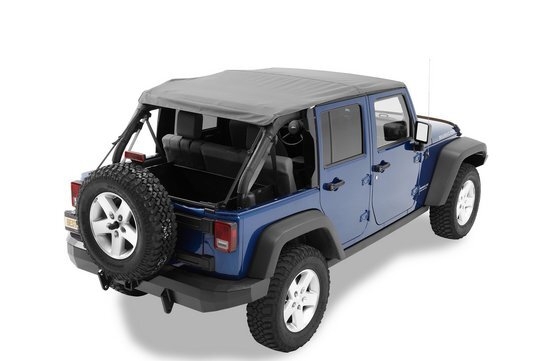Nothing is better than having the wind in your hair and the sun beating down on your Jeep. That feeling is replicated and repeated over and over with Jeep soft tops from Morris 4X4 Center.
As a leading off-road supplies shop, Morris 4X4 Center offers the perfect Jeep top for any adventurer. Learn about the different materials, the pros and cons, and which is best suited for your application below.
Soft Top Materials

Jeep soft tops are one of the popular accessories and come in various materials. What type you need depends on the climate, style, and usage that fits your needs best. Here are the most commonly used materials:
Plastic Soft Tops
Plastic soft tops, often called vinyl tops, are perfect for warmer climates as they offer protection from the sun and wind. They are ideal for beach and off-road adventures as they can easily handle sand, high temperatures, and anything else that nature throws your way.
When the weather rears its ugly head, plastic soft tops are a great way to protect and help you stay nice and dry until better conditions appear. Another great benefit of plastic soft tops is their low weight and easy fitment. After all, going topless is one of the main reasons you bought a Jeep. Right?
As a downside, plastic soft tops are not resistant to harsher weather, and plastic windows have even been known to crack under extreme winter temperatures. This happens because plastic is a brittle material and is prone to cracking when exposed to cold weather.
A premium option for vinyl tops is sailcloth. It cuts out more noise and keeps the interior warmer, all because it’s layered. Most sailcloth soft tops will have two vinyl outside layers and an inner cotton layer.
Twill Soft Tops
The most common soft top material is going to be twill. It isn’t quite the same as your university prof’s jacket or your grandma’s drapes, though. It’s a sturdy, woven fabric that’s usually layered for a soft top to provide insulation from weather and noise better than the rest. There’s an external layer of twill, a layer of butyl rubber that makes it waterproof, and an inner twill layer for style and noise insulation.
Expect to pay a premium for twill tops. Along with being extremely water resistant, they’re warmer and more durable than some of the other options.
Neoprene Soft Tops
Neoprene soft tops are the perfect middle ground between plastic and fabrics soft tops. These are ideal for those living in volatile climates, like four-season states. It's flexible yet waterproof and designed to withstand cold temperatures better than its plastic counterparts.
Another significant aspect of neoprene is the softness and comfort it provides. Its smooth texture makes it comfortable and extremely easy to install over the frame of your Jeep, regardless of the weather conditions.
Often used in wetsuits, neoprene makes an excellent material for getting a watertight, dry, and secure fit to your Jeep. It also provides additional insulation against heat and cold, which makes it great for all seasons. So when that unexpected summer storm comes in, neoprene soft tops will keep you and your passengers dry and happy.
Unfortunately, neoprene soft tops are more expensive than plastic or fabric soft tops. But the added cost reflects the additional benefits and protection provided.
How to Install Your Soft Top

Installinng your soft top is easy. All you need is some basic hand tools and a little bit of patience. If it's a brand-new purchase, take your soft top out of the package and inspect for any defects or damage. Once that's done, you can begin laying it over the Jeep and check the overall dimensions.
Next, you'll attach the mounting brackets to both sides of your Jeep (if it wasn't pre-installed). Some soft tops attach with snap buttons, while others work with velcro. Make sure they are securely attached by tightening them well (but not too tight). This will ensure that everything stays in place through all types of terrain.
Finally, you'll want to double-check the door wraps, window zippers, and the overall fitment of the soft top. This will ensure a secure and watertight seal that won't let any rain in. And you're ready to go!
Cleaning & Maintaining Soft Tops

Cleaning and maintaining your soft top is the key to getting a long life out of it. But how often you clean and maintain your soft top depends on the type of material you have.
Plastic soft tops require a bit more frequent cleaning as they're usually exposed to more dirt, mud, and other stuff that can stain or damage them. You should also avoid using any harsh detergents as this can degrade the plastic over time.
For neoprene soft tops, you don't need to be as worried about dirt or exposure since these materials are designed to weather brutal conditions. Most neoprene soft tops will only need an occasional wipe down with a damp cloth or water-based cleaner every few months.
Regardless of the brand, type, or style you have, make sure not to leave your soft top rolled up when it is still wet, as this can cause mold and damage to the fabric. Also, take off your soft top when you know your Jeep will be parked for extended periods to prevent stretching or sun damage.
No matter which material you choose, soft tops are perfect for getting that open-air experience with your Jeep. And with Morris 4X4 Center's variety of materials and styles, you can find the perfect fit for your off-road adventure! They also offer excellent customer support and assistance for installing your soft top. So get out there, hit the trails, and enjoy the ride!





